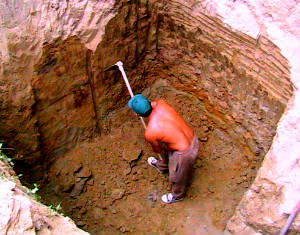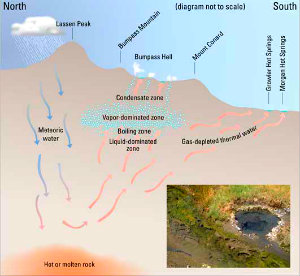What is a Hot Spring and What Makes Hot Spring Water So Hot?
What is a Hot Spring?

those are some pretty good 90 degree angles
he’s got there.
The planet on which we currently reside has a very hot, okay it’s molten, iron core. If you were to start digging a hole, and lots of people have done this for a variety of reasons (mostly economic, though I’m sure there must be a few hole-digger hobbyists out there) – the deeper you get – the hotter the bottom of your hole will be. In fact, some people heat their homes this way by burying pipes containing a liquid into the ground, circulating that liquid through those pipes and into the house and into a heat exchanger. Then heatpumps are used to concentrate the heat which is then distributed throughout the home. These folks are heating their homes using geo thermal energy.
Well that’s pretty smart I figure. However, imagine if you will – a planet – much like our own, where precipitation in the form of liquid water finds its way down into the earth through cracks and faults. In some areas of this orb there are fault lines that not only facilitate the downward travel of said water but also its upwardly mobileness as well. There may also be a layer of permeable rock allowing the water to be transported. Underground pressure will determine just how fast and how far up the water will return. A bit of pressure may result in a flowing underground stream. Add a bit more and you may get some surface seepage. With enough pressure down below there will be a nice, healthy discharge and when the recycled water resurfaces we call it a spring. If these “cracks” or thrust faults lines are associated with geo hot pockets caused by volcanic type of monkey business, the water can heat up pretty darn quickly. And this whole thing can cause this liquid to flow at quite a clip. This is what a hot spring is.

Lassen Volcanic National Park. Note the
lack of a thrust fault.
Inset is a photo of a hot mud pot.
What Makes Hot Spring Water so Hot?
As mentioned above, generally speaking – the deeper the water goes down – the hotter it gets. The reasoning is that that is where the magma is. If there is a “crack” or thrust fault (one layer of the crust breaking and being thrust over another) this breach will allow a tremendous amount of heat to be transferred from the magma goo up into the surrounding rock. These hot pockets can reach up toward the surface quite a distance, though, the further from the heat source – the magma – the less thermal energy still in the rock layers. Now if you imagine that water down there, with all that thermal energy being transferred from the rocks along that thrust fault to the water… the water getting hotter and hotter… and more water making its way from the surface creating more and more pressure. Heat + pressure = velocity. The faster the water rises to the surface along this thrust fault means that there is less time for it to lose its heat. Ergo: this is what makes hot spring water so hot.
We learned above that we can have cool springs wherein the water did not really absorb any measurable amount of heat. There are also thermal springs where the water is a bit warmer than the air temperature and hot springs where the water is hot. I prefer hot for soaking, cool for drinking, and thermal when looking for interesting critters.
But mostly I prefer hot for soaking.




I want to know more about how hot springs are formed. I didn’t know that hot springs are formed when a layer of the earth’s crust brakes and is thrust into another, making it so that the heat from the center of the planet escapes trough it. I think it’s interesting how these things happen and how it is manifested on the surface.